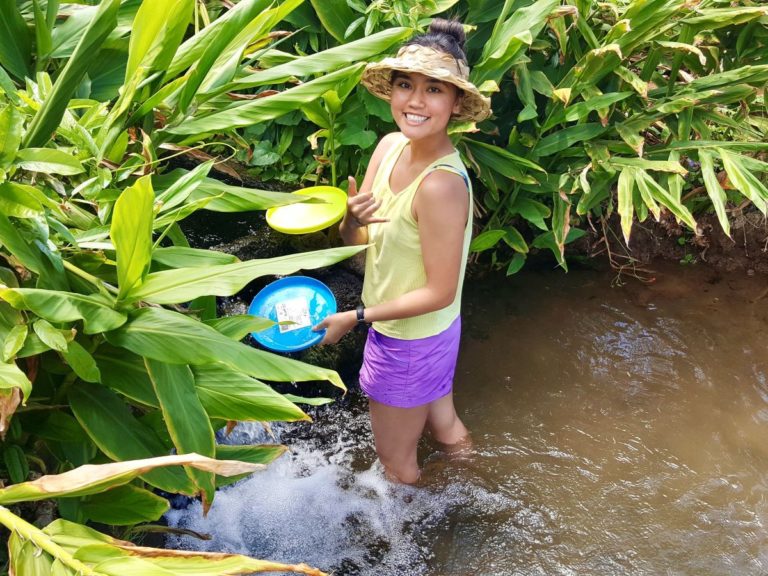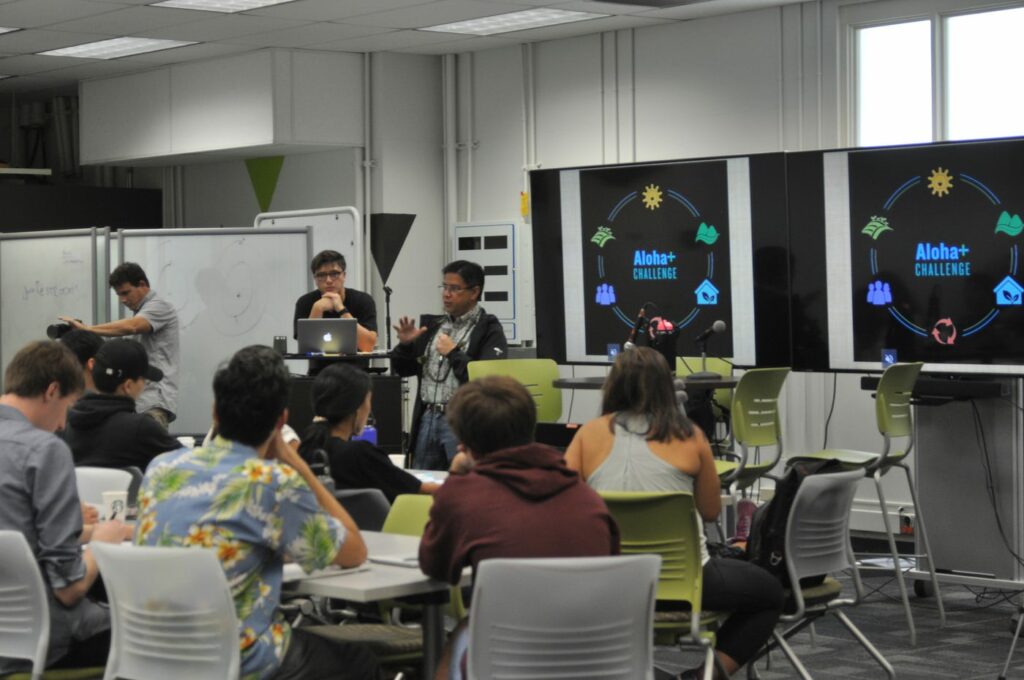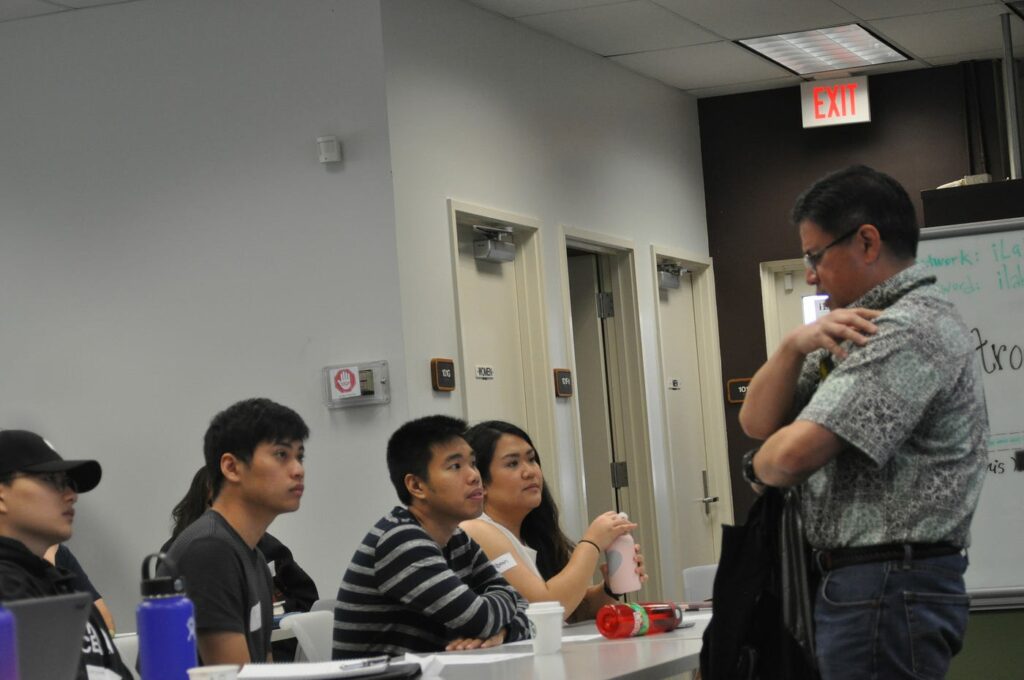

Purple Prize documentarian, Kalei Akau shares part two of her reflections from the 2019 Purple Prize . Please read part one, “Piko ʻAumakua: Building Empathy & Forging Roots” first.
ʻIewe translates to afterbirth, or the placenta; it also refers to relatives of common ancestry (Pukui Hawaiian Dictionary, p.94). Our piko ʻiewe embodies the connection we have to our birthplace and immediate family through the physical placenta. Our piko ʻiewe also embodies the connection between the physical and spiritual. Our piko ʻiewe is the most visible of our three piko as well as where our naʻau, or gut is located. It is through our naʻau that we sometimes are overcome with an inexplicable intuition. While we exist in the physical, our naʻau and piko ʻiewe connect us to what is in the present.
To engage our piko ʻiewe is to participate in activities, processes and resources that support and uplift our present ʻohana. The following workshops of the Connections Phase helped us engage and strengthen our piko ʻiewe.
From the kickoff day and first workshops in February and March, the Connections Phase grounded its community in piko ʻaumakua as we learned about the history, practice and framework of indigenous innovation. It was now time to look outward to our communities– to connect and engage with the current local, social and environmental impact opportunities.
The third step in Equity Centered Community Design is to acknowledge and dismantle power structures. The Purple Prize challenges its cohort to build and innovate within larger systems such as government, education and private industries, and to subvert dominant practices that value extraction over regeneration and money over people. But how do we move from acknowledging these dominant power structures to taking action and dismantling them? The next month of Connections Phase focused on tackling this daunting task of putting theory into practice.
Thought leader in sustainability, board member of Hawaii Green Growth and CEO of the Oahu Economic Development Board, Pono Shim opened the Local, Social and Environmental Impact Opportunities (LSEIO) workshop challenging us to dig deeper than our current operating system and engage our naʻau. He used the example of DNA test kits like 23AndMe and AncestryDNA to explain this lesson. With a saliva sample or a hair follicle, these kits tell us the exact percentage of our ethnic makeup. Pono noted that while DNA testing sheds light on our regional roots, it is not able to share the rich stories in our family history; with a DNA test, we are only able to uncover what is already known.
Much like DNA kits, the fixes we often apply to monumental issues like climate change only encompass what is already known. Pono urged us to instead focus on solutions that innovate beyond what we already know. He specifically pointed to the potential we have to collectively solve our generation’s biggest issues. Pono noted, “We as individuals have the power to enact change through our lifestyle but do not have the power to follow through.” It is the follow through where innovation and real change takes place.

Pono spoke about the Aloha+ Challenge, a statewide public-private sector initiative that outlines relevant goals, metrics and indicators that track Hawaii’s progress toward achieving the global Sustainable Development Goals (SDGs). The 2014 Aloha+ Challenge became a reality because individuals from various backgrounds were able to come together, establish common goals and leverage Hawaii’s role in creating a sustainable future. The challenge identifies and tracks goals in six areas: clean energy, local food production, natural resource management, solid waste reduction, smart sustainable communities and green workforce and education.

Deeply ingrained in collective action and working toward common goals like the Aloha+ Challenge are the concepts of hana and ʻohana. Because of Lilo and Stitch, ʻohana is a well-known term for “family” around the world and hana is popularized from the term pauhana, which signals the end of the workday. Although we often times equate hana with our job, the term digs much deeper than our work obligations.
Pono showed us the following breakdown of hana. Hā is our breath, n(oa) is to release and a(kahai) is with grace. Hana symbolizes the act of releasing our breath–or spirit–with grace. In our hana, our work leaves something better than it was found. Our hana is much deeper and lasting than our job titles or salaries we chase until retirement. Similarly, ʻohana does not simply represent family. O is forever or everlasting; coupled with hana, ʻohana is the concept of hana in perpetuity. In our ʻohana, our hana is for each other and our future generations.
To practice the values of hana and ʻohana, Pono noted that we must first recognize our hana muscles so it eventually becomes just as strong as our transaction-based work. The energy shifted in the room as we moved through the day, ready to recognize, learn and engage our hana muscles.
The fourth step in ECCD is to define and assess community needs. The better we understand our community, the better we can focus on the needs and the causes of why those needs are not being met. This is an integral step to begin designing solutions to improve our community’s future. The underlying lesson in this fourth step is simple: we cannot create a solution without first understanding the problem.

With our communities in mind, the next segment of the LSEIO workshop, Alec led a fireside chat with community leaders Celeste Connors of Hawaii Green Growth and Kevin Chang of Kuaʻāina Ulu Auamo (KUA). He asked Celeste and Kevin to reflect on their experiences building meaningful, appropriate and uplifting partnerships where collective problem solving can take place.
Celeste reflected on her time from the foreign service to her role as Director of Energy and Climate on the Obama Administration’s National Security Council and National Economic Council to her role as Hawaii Green Growth’s Executive Director. She credits her upbringing in Maunawili providing a foundation in understanding and embracing the values of indigenous knowledge when developing the UN’s Sustainable Development Goals (SDGs). “There is a direct connection between the loʻi kalo to the United Nations climate change negotiations,” Celeste noted. In fact, the UN looked to Hawaiʻi and the Aloha+ Challenge to implement their SDGs in a culturally relevant and appropriate way. Celeste remarked, “Unless you are thinking locally, you are not actually thinking about what matters to people and communities.”

Although Celeste’s background has been global facing, her work at Hawaiʻi Green Growth is both distinctly global and local. A member of the Global Island Partnership (GLISPA), Hawaiʻi Green Growth represents Hawaiʻi among island economies like Taiwan and Palau. “Islands are natural laboratories for innovation. Our scale is our asset where we can more quickly pioneer solutions,” Celeste noted. As an island economy, Hawaiʻi has a unique opportunity to be a global leader in innovating local, place-based solutions.
For Kevin Chang, monumental change does not solely stem from governance and policymaking. His organization, Kuaʻāina Ulu ʻAumamo or KUA came into fruition from a loose network of near shore fishing communities when they decided to create a permanent mechanism to discuss common issues and implement meaningful changes in their work. Kuaʻāina Ulu ʻAuamo translates to “grassroots growing through shared responsibility” and kua translates to “backbone.” While policymaking and governance looks at issues broadly, grassroots, place-based knowledge connects big issues like sustainability to the local level. Practical, local and situated knowledge is therefore important although often overlooked. Kevin and KUA work for the practitioners who hold such local knowledge and are working to rebuild it whether it is in near-shore fishing, harvesting limu or managing a loko iʻa.Learn more about the E Alu Pū network in this short video from KUA.
Together with its networks of near-shore fishermen, limu practitioners and loko iʻa kiaʻi, KUA works to perpetuate practices that mālama of our environment and rebuild regenerative ecosystems. Before connecting with each other, many practitioners found their partnerships driven by outside groups– the government, larger NGOs and policymakers. These communities found their goals and metrics being set by outside partners and not themselves.
To be more autonomous, these communities decided to strengthen their vision creating grassroots networks. KUA works to first hoʻopili–to come together–and connect kuaʻāina organizations across the state to each other through three networks to establish a common vision and goals. From these networks of local organizations, KUA then facilitates hoʻohui–to join–and reaches out to larger NGOs, local government offices and other private sector organizations to establish partnerships that are collaborative. Kevin emphasized that KUA’s work is not unique, “indigenous peoples and local communities are doing this everywhere.” He shared stories of his latest WhatsApp messages from an Amazonian chief who meets with uncontacted tribes to help them negotiate their territory with mining and forestry companies and a human rights attorney in Kenya who is helping his people negotiate their forestry access.
“The best opportunities are in the middle.” This was a guiding message both Celeste and Kevin shared in their manaʻo to the Purple Prize teams. To engage our piko ʻiewe, interdependent partnerships that meet in the middle and center community are the foundation for creating monumental change.
University of Hawaii’s System Sustainability Coordinator and Mauka Marketplace co-founder, Matt Lynch brought our introduction to piko ʻiewe full circle. He introduced us to the practice of permaculture as a model of a regenerative economy. Permaculture is a design principle based on whole systems thinking that directly utilizes and draws inspiration from resilient features in our natural ecosystems. A regenerative economy mirrors the design principles of permaculture to build an ecosystem of enterprises that work together to address and produce 8 forms of capital.

Authors of Regenerative Enterprise: Optimizing for Multi-Capital Abundance, Ethan Roland and Gregory Landua outline valuable resources, which an individual or entity could gather or exchange in a regenerative economy. They enumerated these resources to eight forms of capital– social, material, financial, living, intellectual, experiential (or human), spiritual and cultural capital. Together, these eight forms of capital broadly map out the resources in our world that can be held and exchanged in an economy. This principle emphasizes that money is not the only form of capital flowing around and through us. Instead, the concept of wealth includes all eight resources that provide a foundation to build a regenerative economy.

To illustrate the permaculture principles in building a regenerative economy, Matt shared an example of three enterprises– a tree planting service, a wood craftsman and a volunteer organization. Each enterprise holds a different form of capital but collectively, work together to exchange capital. The volunteer organization has the human capital. It can exchange its labor with the craftsman, who has intellectual capital, for manufactured wood products. The craftsman can exchange–relying on its relationship to the volunteer organization–with the tree planting service, who hold the material capital. As a result, all three enterprises exchange their own forms of capital rather than optimizing solely for financial gain. Matt concluded that in a regenerative economy, business can build a surplus of their capital and exchange them as currency.
As the Purple Prize teams begin to innovate and design community centered solutions, we are inspired by Pono’s message to do our hana with deeper meaning and intention; we are grateful for Celeste and Kevin’s guidance to build interdependent partnerships that meet in the middle; and we are ready to engage our piko ʻiewe and stretch our hana muscles to connect to our own form of capital and collectively build an indigenous innovation economy. Purple Prize teams together create an ecosystem of enterprises–a regenerative economy–bringing different forms of capital that collectively work toward the common goal of strengthening our indigenous values, practices and thought.